Quantitative Research Methods for Social Scientists: A Detailed Report
VerifiedAdded on 2023/06/17
|7
|1458
|274
Report
AI Summary
This report delves into quantitative research methods for social scientists, covering four levels of measurement (nominal, ordinal, interval, and ratio) with examples. It explains measures of central tendency (mean, median, mode) and dispersion (standard deviation), differentiating between descriptive and inferential statistics. The report clarifies hypothesis testing, independent and dependent variables, and extraneous variables. Finally, it interprets results from frequency tables, cross-tabulations, chi-square tests, and Phi/Cramer's V, providing a comprehensive overview of quantitative data analysis in social science research. Access more solved assignments and study resources on Desklib.

Quantitative Research
Methods for Social Scientists
Methods for Social Scientists
Paraphrase This Document
Need a fresh take? Get an instant paraphrase of this document with our AI Paraphraser
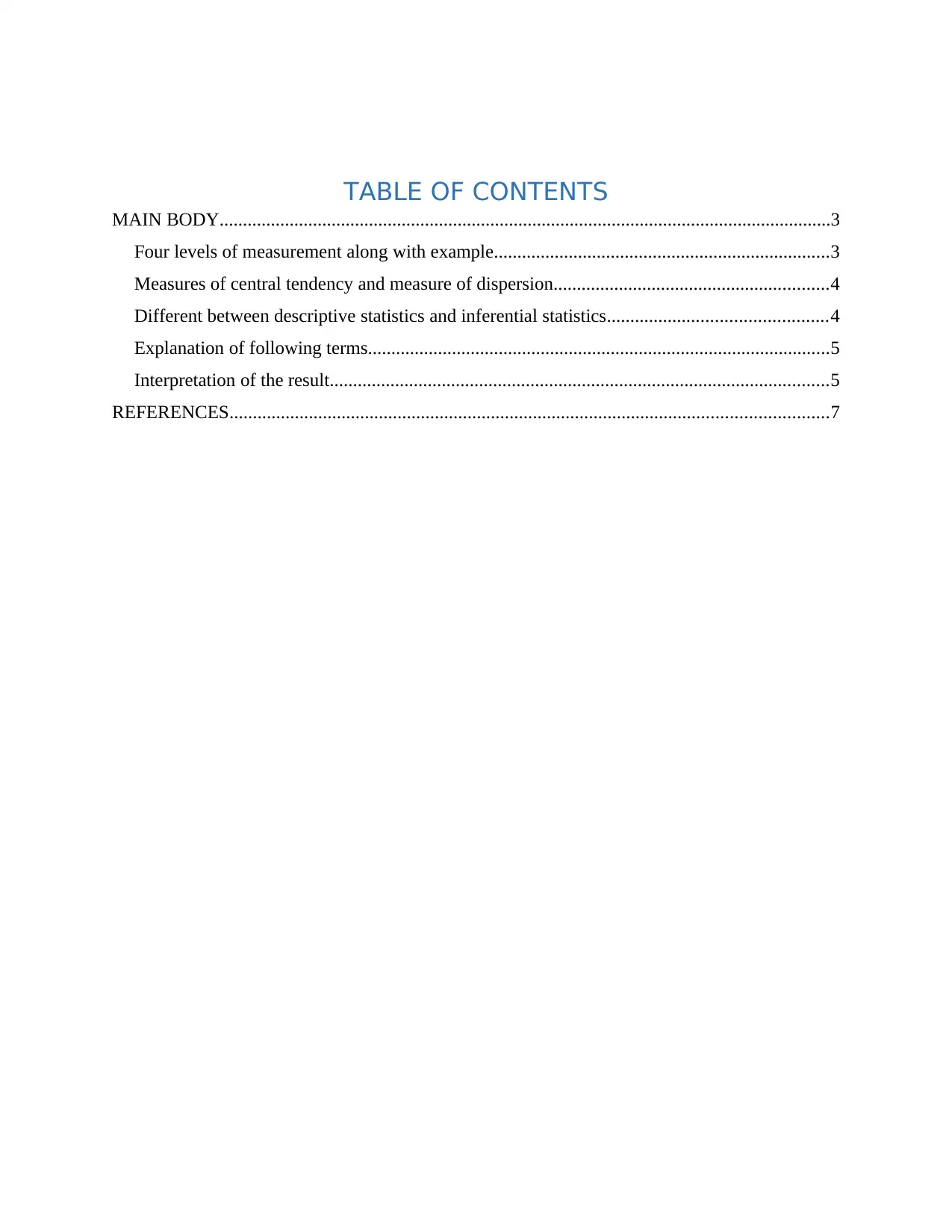
TABLE OF CONTENTS
MAIN BODY...................................................................................................................................3
Four levels of measurement along with example........................................................................3
Measures of central tendency and measure of dispersion...........................................................4
Different between descriptive statistics and inferential statistics...............................................4
Explanation of following terms...................................................................................................5
Interpretation of the result...........................................................................................................5
REFERENCES................................................................................................................................7
MAIN BODY...................................................................................................................................3
Four levels of measurement along with example........................................................................3
Measures of central tendency and measure of dispersion...........................................................4
Different between descriptive statistics and inferential statistics...............................................4
Explanation of following terms...................................................................................................5
Interpretation of the result...........................................................................................................5
REFERENCES................................................................................................................................7
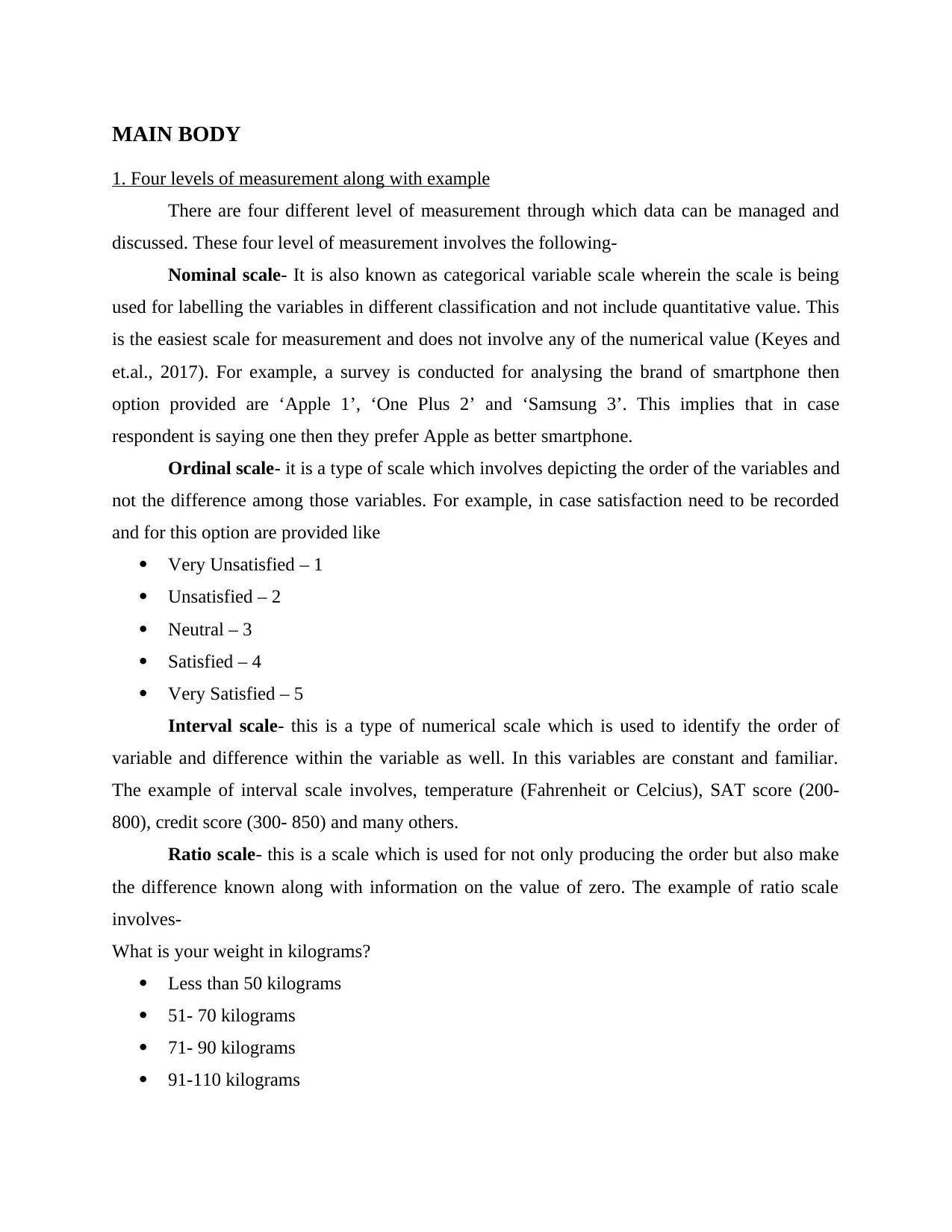
MAIN BODY
1. Four levels of measurement along with example
There are four different level of measurement through which data can be managed and
discussed. These four level of measurement involves the following-
Nominal scale- It is also known as categorical variable scale wherein the scale is being
used for labelling the variables in different classification and not include quantitative value. This
is the easiest scale for measurement and does not involve any of the numerical value (Keyes and
et.al., 2017). For example, a survey is conducted for analysing the brand of smartphone then
option provided are ‘Apple 1’, ‘One Plus 2’ and ‘Samsung 3’. This implies that in case
respondent is saying one then they prefer Apple as better smartphone.
Ordinal scale- it is a type of scale which involves depicting the order of the variables and
not the difference among those variables. For example, in case satisfaction need to be recorded
and for this option are provided like
Very Unsatisfied – 1
Unsatisfied – 2
Neutral – 3
Satisfied – 4
Very Satisfied – 5
Interval scale- this is a type of numerical scale which is used to identify the order of
variable and difference within the variable as well. In this variables are constant and familiar.
The example of interval scale involves, temperature (Fahrenheit or Celcius), SAT score (200-
800), credit score (300- 850) and many others.
Ratio scale- this is a scale which is used for not only producing the order but also make
the difference known along with information on the value of zero. The example of ratio scale
involves-
What is your weight in kilograms?
Less than 50 kilograms
51- 70 kilograms
71- 90 kilograms
91-110 kilograms
1. Four levels of measurement along with example
There are four different level of measurement through which data can be managed and
discussed. These four level of measurement involves the following-
Nominal scale- It is also known as categorical variable scale wherein the scale is being
used for labelling the variables in different classification and not include quantitative value. This
is the easiest scale for measurement and does not involve any of the numerical value (Keyes and
et.al., 2017). For example, a survey is conducted for analysing the brand of smartphone then
option provided are ‘Apple 1’, ‘One Plus 2’ and ‘Samsung 3’. This implies that in case
respondent is saying one then they prefer Apple as better smartphone.
Ordinal scale- it is a type of scale which involves depicting the order of the variables and
not the difference among those variables. For example, in case satisfaction need to be recorded
and for this option are provided like
Very Unsatisfied – 1
Unsatisfied – 2
Neutral – 3
Satisfied – 4
Very Satisfied – 5
Interval scale- this is a type of numerical scale which is used to identify the order of
variable and difference within the variable as well. In this variables are constant and familiar.
The example of interval scale involves, temperature (Fahrenheit or Celcius), SAT score (200-
800), credit score (300- 850) and many others.
Ratio scale- this is a scale which is used for not only producing the order but also make
the difference known along with information on the value of zero. The example of ratio scale
involves-
What is your weight in kilograms?
Less than 50 kilograms
51- 70 kilograms
71- 90 kilograms
91-110 kilograms
⊘ This is a preview!⊘
Do you want full access?
Subscribe today to unlock all pages.

Trusted by 1+ million students worldwide

More than 110 kilograms
2. Measures of central tendency and measure of dispersion
The measure of central tendency involves identifying a single value which describes the
data set that is the central position of the data set. This can also be stated as summary measures
which provides a centre point of the data being provided (Rayat, 2018). This can be calculated
with help of different tools and techniques. These techniques involve use of mean, median and
mode for analysing the central value of the complete data set being provided.
On the other hand, measure of dispersion is a tool to assist the researcher in interpreting
the variability of the data being present. This is used in order to identify that how much the data
is homogenous or heterogeneous and to analyse how much dispersion is present in the data.
Also, this dispersion of data evaluates the fact that how much scattered or squeezed is the data
(Wooditch and et.al., 2021). There are many different methods of analysing dispersion of data
but the most common and reliable is the standard deviation. With help of the standard deviation a
person can analyse the fact that how much dispersed is the data within the set.
3. Different between descriptive statistics and inferential statistics
Descriptive statistics Inferential statistics
It is being defined as the type of statistics
which majorly deals with describing the
population which is present in the study.
On the other side, inferential statistics is the
one which has a major focus on drawing
conclusion relating to population.
This undertakes the use of organising,
analysing and presenting the data in
informative manner.
Under inferential statistics, it compares the
data and predict the data.
The results of descriptive statistics involve the
presentation with help of charts, graphs and
tables (Amrhein, Trafimow and Greenland,
2019).
Whereas the presentation of inferential
statistics is done on basis of probability.
The descriptive statistics is being used to
describe a situation.
On the other side, inferential statistics is used
to explain the chance of occurrence of the
event.
Descriptive statistics focuses on explaining the Whereas, inferential statistics focuses on
2. Measures of central tendency and measure of dispersion
The measure of central tendency involves identifying a single value which describes the
data set that is the central position of the data set. This can also be stated as summary measures
which provides a centre point of the data being provided (Rayat, 2018). This can be calculated
with help of different tools and techniques. These techniques involve use of mean, median and
mode for analysing the central value of the complete data set being provided.
On the other hand, measure of dispersion is a tool to assist the researcher in interpreting
the variability of the data being present. This is used in order to identify that how much the data
is homogenous or heterogeneous and to analyse how much dispersion is present in the data.
Also, this dispersion of data evaluates the fact that how much scattered or squeezed is the data
(Wooditch and et.al., 2021). There are many different methods of analysing dispersion of data
but the most common and reliable is the standard deviation. With help of the standard deviation a
person can analyse the fact that how much dispersed is the data within the set.
3. Different between descriptive statistics and inferential statistics
Descriptive statistics Inferential statistics
It is being defined as the type of statistics
which majorly deals with describing the
population which is present in the study.
On the other side, inferential statistics is the
one which has a major focus on drawing
conclusion relating to population.
This undertakes the use of organising,
analysing and presenting the data in
informative manner.
Under inferential statistics, it compares the
data and predict the data.
The results of descriptive statistics involve the
presentation with help of charts, graphs and
tables (Amrhein, Trafimow and Greenland,
2019).
Whereas the presentation of inferential
statistics is done on basis of probability.
The descriptive statistics is being used to
describe a situation.
On the other side, inferential statistics is used
to explain the chance of occurrence of the
event.
Descriptive statistics focuses on explaining the Whereas, inferential statistics focuses on
Paraphrase This Document
Need a fresh take? Get an instant paraphrase of this document with our AI Paraphraser
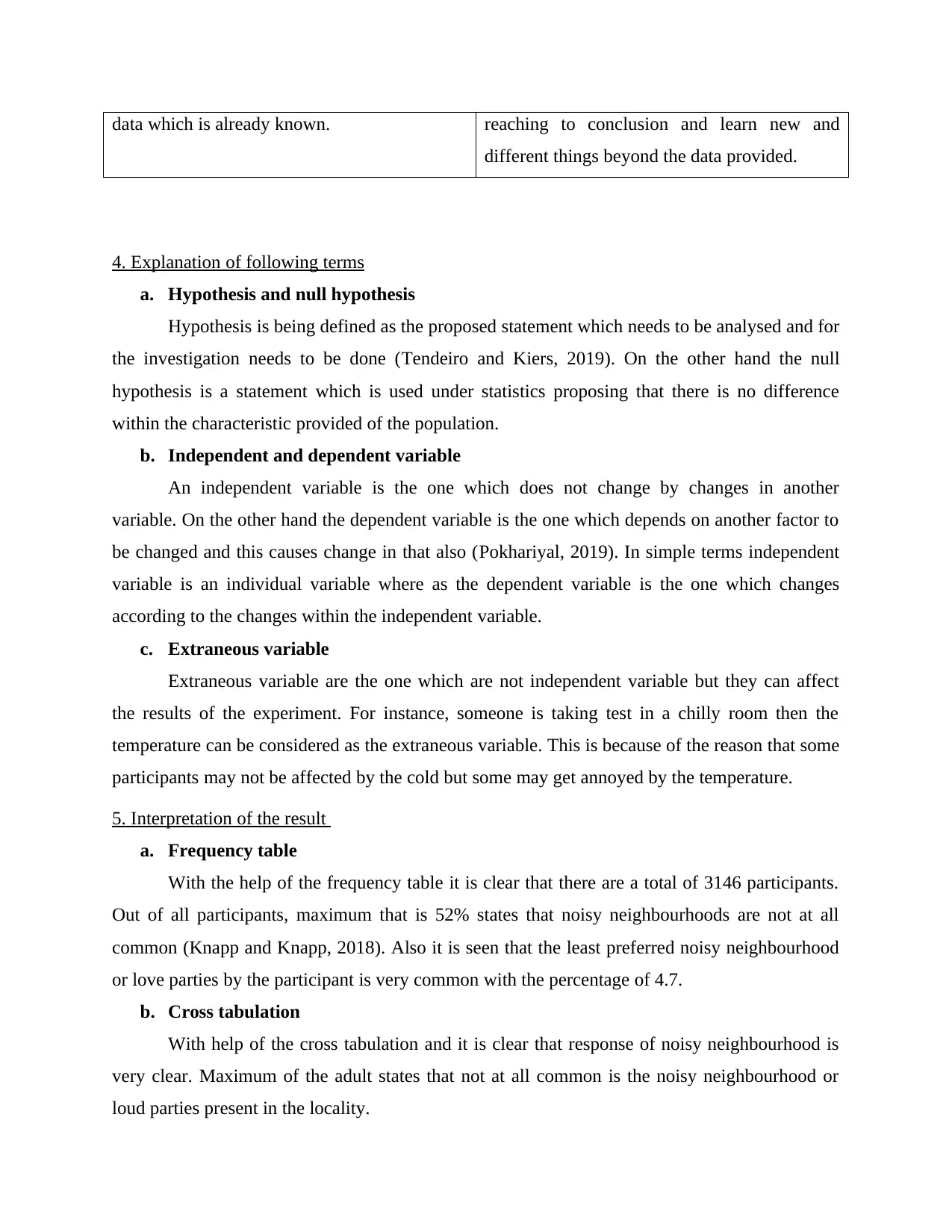
data which is already known. reaching to conclusion and learn new and
different things beyond the data provided.
4. Explanation of following terms
a. Hypothesis and null hypothesis
Hypothesis is being defined as the proposed statement which needs to be analysed and for
the investigation needs to be done (Tendeiro and Kiers, 2019). On the other hand the null
hypothesis is a statement which is used under statistics proposing that there is no difference
within the characteristic provided of the population.
b. Independent and dependent variable
An independent variable is the one which does not change by changes in another
variable. On the other hand the dependent variable is the one which depends on another factor to
be changed and this causes change in that also (Pokhariyal, 2019). In simple terms independent
variable is an individual variable where as the dependent variable is the one which changes
according to the changes within the independent variable.
c. Extraneous variable
Extraneous variable are the one which are not independent variable but they can affect
the results of the experiment. For instance, someone is taking test in a chilly room then the
temperature can be considered as the extraneous variable. This is because of the reason that some
participants may not be affected by the cold but some may get annoyed by the temperature.
5. Interpretation of the result
a. Frequency table
With the help of the frequency table it is clear that there are a total of 3146 participants.
Out of all participants, maximum that is 52% states that noisy neighbourhoods are not at all
common (Knapp and Knapp, 2018). Also it is seen that the least preferred noisy neighbourhood
or love parties by the participant is very common with the percentage of 4.7.
b. Cross tabulation
With help of the cross tabulation and it is clear that response of noisy neighbourhood is
very clear. Maximum of the adult states that not at all common is the noisy neighbourhood or
loud parties present in the locality.
different things beyond the data provided.
4. Explanation of following terms
a. Hypothesis and null hypothesis
Hypothesis is being defined as the proposed statement which needs to be analysed and for
the investigation needs to be done (Tendeiro and Kiers, 2019). On the other hand the null
hypothesis is a statement which is used under statistics proposing that there is no difference
within the characteristic provided of the population.
b. Independent and dependent variable
An independent variable is the one which does not change by changes in another
variable. On the other hand the dependent variable is the one which depends on another factor to
be changed and this causes change in that also (Pokhariyal, 2019). In simple terms independent
variable is an individual variable where as the dependent variable is the one which changes
according to the changes within the independent variable.
c. Extraneous variable
Extraneous variable are the one which are not independent variable but they can affect
the results of the experiment. For instance, someone is taking test in a chilly room then the
temperature can be considered as the extraneous variable. This is because of the reason that some
participants may not be affected by the cold but some may get annoyed by the temperature.
5. Interpretation of the result
a. Frequency table
With the help of the frequency table it is clear that there are a total of 3146 participants.
Out of all participants, maximum that is 52% states that noisy neighbourhoods are not at all
common (Knapp and Knapp, 2018). Also it is seen that the least preferred noisy neighbourhood
or love parties by the participant is very common with the percentage of 4.7.
b. Cross tabulation
With help of the cross tabulation and it is clear that response of noisy neighbourhood is
very clear. Maximum of the adult states that not at all common is the noisy neighbourhood or
loud parties present in the locality.
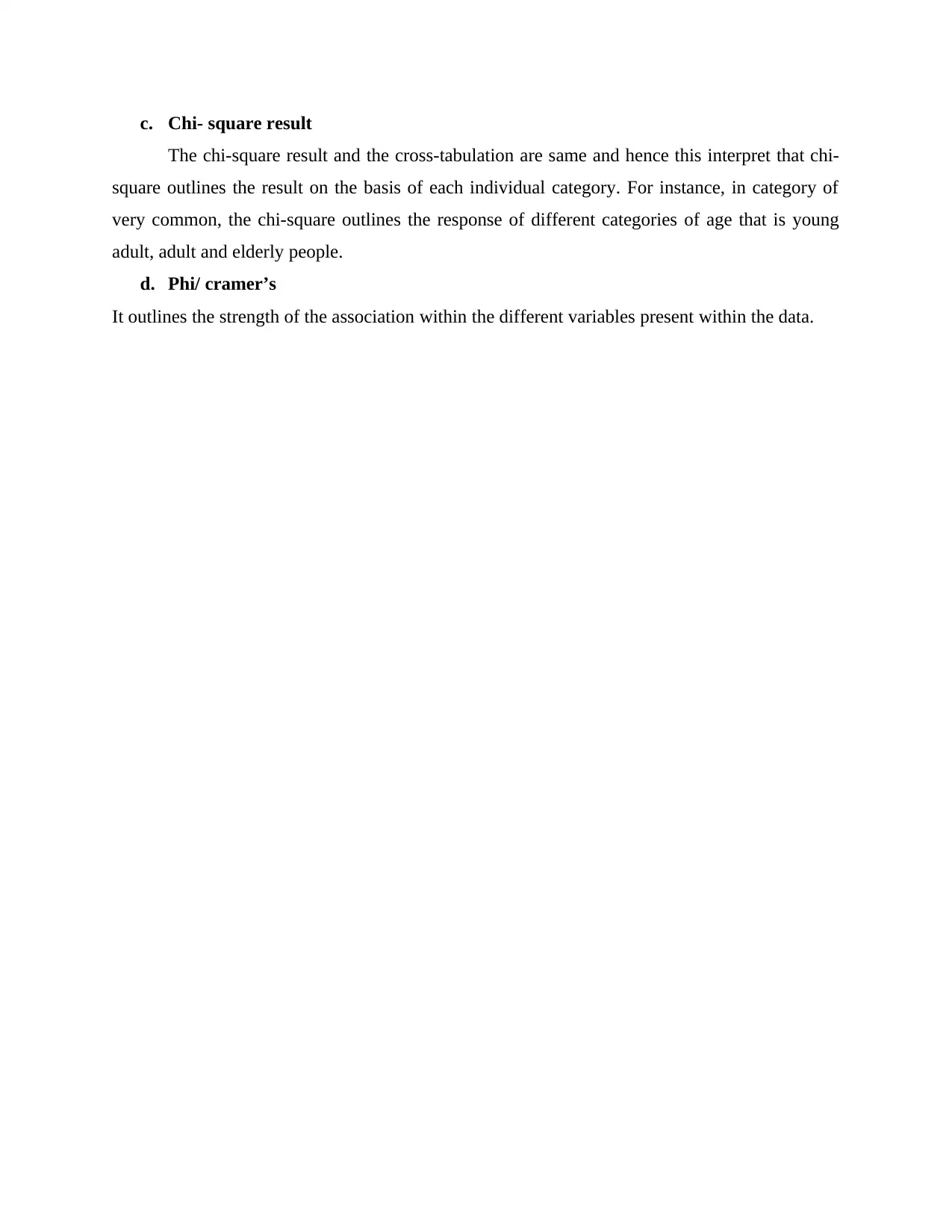
c. Chi- square result
The chi-square result and the cross-tabulation are same and hence this interpret that chi-
square outlines the result on the basis of each individual category. For instance, in category of
very common, the chi-square outlines the response of different categories of age that is young
adult, adult and elderly people.
d. Phi/ cramer’s
It outlines the strength of the association within the different variables present within the data.
The chi-square result and the cross-tabulation are same and hence this interpret that chi-
square outlines the result on the basis of each individual category. For instance, in category of
very common, the chi-square outlines the response of different categories of age that is young
adult, adult and elderly people.
d. Phi/ cramer’s
It outlines the strength of the association within the different variables present within the data.
⊘ This is a preview!⊘
Do you want full access?
Subscribe today to unlock all pages.

Trusted by 1+ million students worldwide
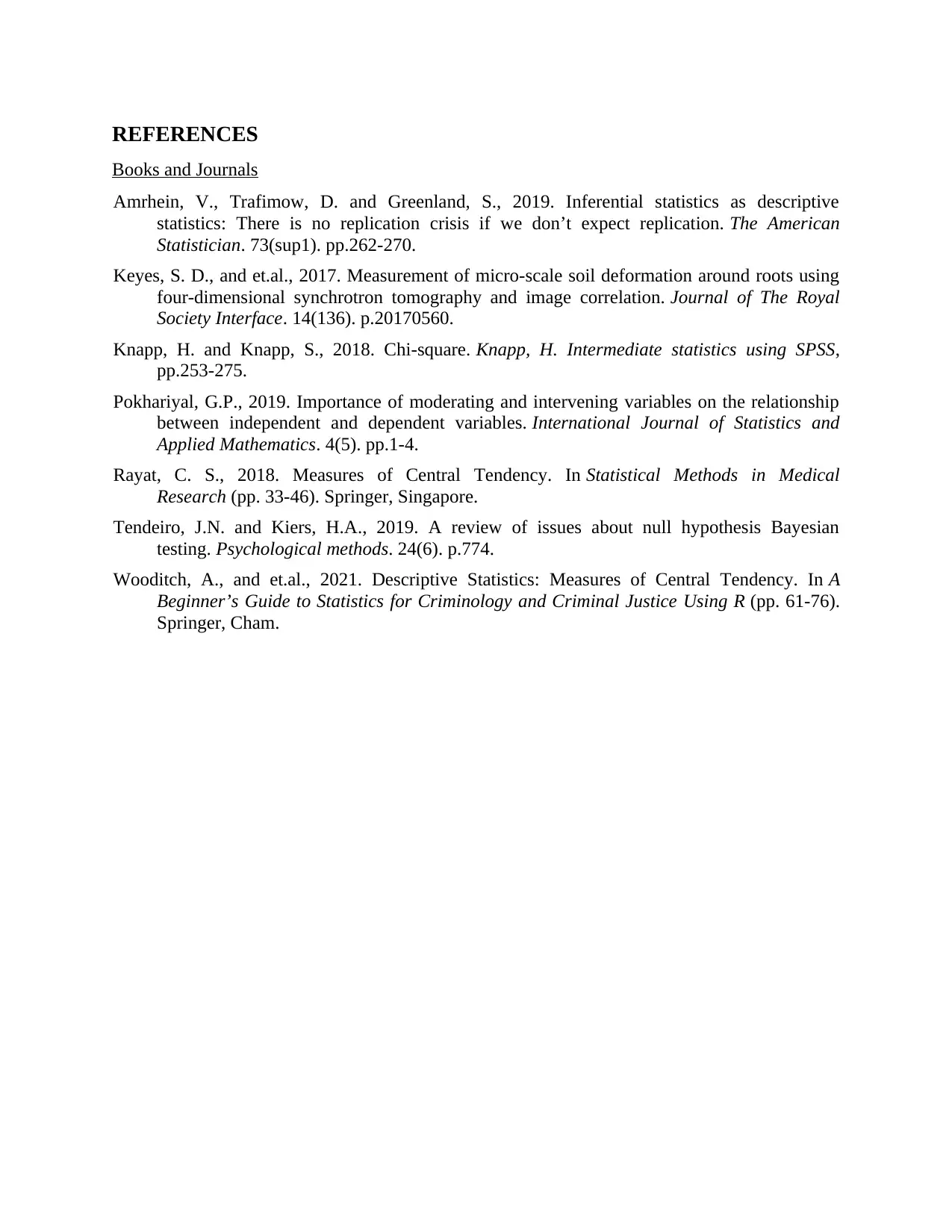
REFERENCES
Books and Journals
Amrhein, V., Trafimow, D. and Greenland, S., 2019. Inferential statistics as descriptive
statistics: There is no replication crisis if we don’t expect replication. The American
Statistician. 73(sup1). pp.262-270.
Keyes, S. D., and et.al., 2017. Measurement of micro-scale soil deformation around roots using
four-dimensional synchrotron tomography and image correlation. Journal of The Royal
Society Interface. 14(136). p.20170560.
Knapp, H. and Knapp, S., 2018. Chi-square. Knapp, H. Intermediate statistics using SPSS,
pp.253-275.
Pokhariyal, G.P., 2019. Importance of moderating and intervening variables on the relationship
between independent and dependent variables. International Journal of Statistics and
Applied Mathematics. 4(5). pp.1-4.
Rayat, C. S., 2018. Measures of Central Tendency. In Statistical Methods in Medical
Research (pp. 33-46). Springer, Singapore.
Tendeiro, J.N. and Kiers, H.A., 2019. A review of issues about null hypothesis Bayesian
testing. Psychological methods. 24(6). p.774.
Wooditch, A., and et.al., 2021. Descriptive Statistics: Measures of Central Tendency. In A
Beginner’s Guide to Statistics for Criminology and Criminal Justice Using R (pp. 61-76).
Springer, Cham.
Books and Journals
Amrhein, V., Trafimow, D. and Greenland, S., 2019. Inferential statistics as descriptive
statistics: There is no replication crisis if we don’t expect replication. The American
Statistician. 73(sup1). pp.262-270.
Keyes, S. D., and et.al., 2017. Measurement of micro-scale soil deformation around roots using
four-dimensional synchrotron tomography and image correlation. Journal of The Royal
Society Interface. 14(136). p.20170560.
Knapp, H. and Knapp, S., 2018. Chi-square. Knapp, H. Intermediate statistics using SPSS,
pp.253-275.
Pokhariyal, G.P., 2019. Importance of moderating and intervening variables on the relationship
between independent and dependent variables. International Journal of Statistics and
Applied Mathematics. 4(5). pp.1-4.
Rayat, C. S., 2018. Measures of Central Tendency. In Statistical Methods in Medical
Research (pp. 33-46). Springer, Singapore.
Tendeiro, J.N. and Kiers, H.A., 2019. A review of issues about null hypothesis Bayesian
testing. Psychological methods. 24(6). p.774.
Wooditch, A., and et.al., 2021. Descriptive Statistics: Measures of Central Tendency. In A
Beginner’s Guide to Statistics for Criminology and Criminal Justice Using R (pp. 61-76).
Springer, Cham.
1 out of 7
Related Documents
Your All-in-One AI-Powered Toolkit for Academic Success.
+13062052269
info@desklib.com
Available 24*7 on WhatsApp / Email
![[object Object]](/_next/static/media/star-bottom.7253800d.svg)
Unlock your academic potential
Copyright © 2020–2025 A2Z Services. All Rights Reserved. Developed and managed by ZUCOL.

